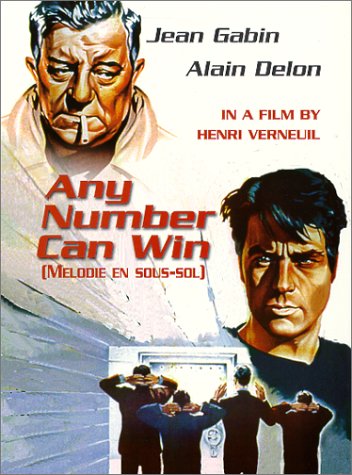
Here’s one more post reviewing the terrific flicks shown as part of the AFI and the Film Noir Foundation’s festival Noir City International, and this time it’s the French Any Number Can Win, starring the phenomenal Jean Gabin and a (super young and handsome) Alain Delon. It’s a wonderful heist movie: the Gabin character, Charles, has just come home after a long period in prison. Contemplating his grim chances at reentry with his wife (they have such a great relationship) he realizes that going straight isn’t worth it. He partners with Francis (Delon) and Louis (Maurice Biraud) to plan a big heist at the outrageously named Palm Beach Casino.
Lots of fantastic things happen; the cinematography is phenomenal, as is the ensemble acting, especially the dance of suspicion between Charles and Francis. But from a criminological perspective, what sticks out is the use of physical environment as a partner in crime as well as an incriminating accomplice. This dovetails with a theory that came to prominence in criminology in the 1980s, Situational Crime Prevention. Despairing of grand theories involving the criminal’s character or big social structures, leading criminologists at the time turned their attention to the physical environment of crime, to check whether it creates opportunities to commit crime or to avoid detection. The leading theorists advancing these theories seem to assume some rationality and planning on the part of criminals (there’s still excellent work being done on this, specifically regarding burglaries and poaching), and are looking for ways in which the setups in stores, for example, entice stealing, hinder detection, and enable getting away. This theory was very attractive to the Thatcher and Reagan administrations, respectively, and shaped much of the physical environs in both countries. If you’ve ever seen an athletics store with a display wall with only one sneaker, or a park bench with armrests in the middle (to prevent sleeping) you’ve seen situational crime prevention in action.
Anyway, the way this plays out in Any Number Can Win is fascinating. According to Charles’ plan, Francis takes a room in a mansion next door to the casino, and rents a pool cabana. It turns out that the air vents in the cabana lead to the ventilation inside the casino, and the entire plan is based on using the infrastructure between the two buildings effectively. This means we get to see Delon in some hairy situations, which require athleticism and agility, such as crawling through air vents or leaping inside an elevator shaft. But what makes the plan appealing is also what brings about its inevitable failure: the environment does not cooperate. I won’t tell you what happens–I’ll just mention that some of the most fantastic 1960s-style resort extravagance ends up tripping our fellows and sabotaging their best-laid plans.
A great accompanying read to this movie is Geoff Manaugh’s A Burglar’s Guide to the City.




No comment yet, add your voice below!